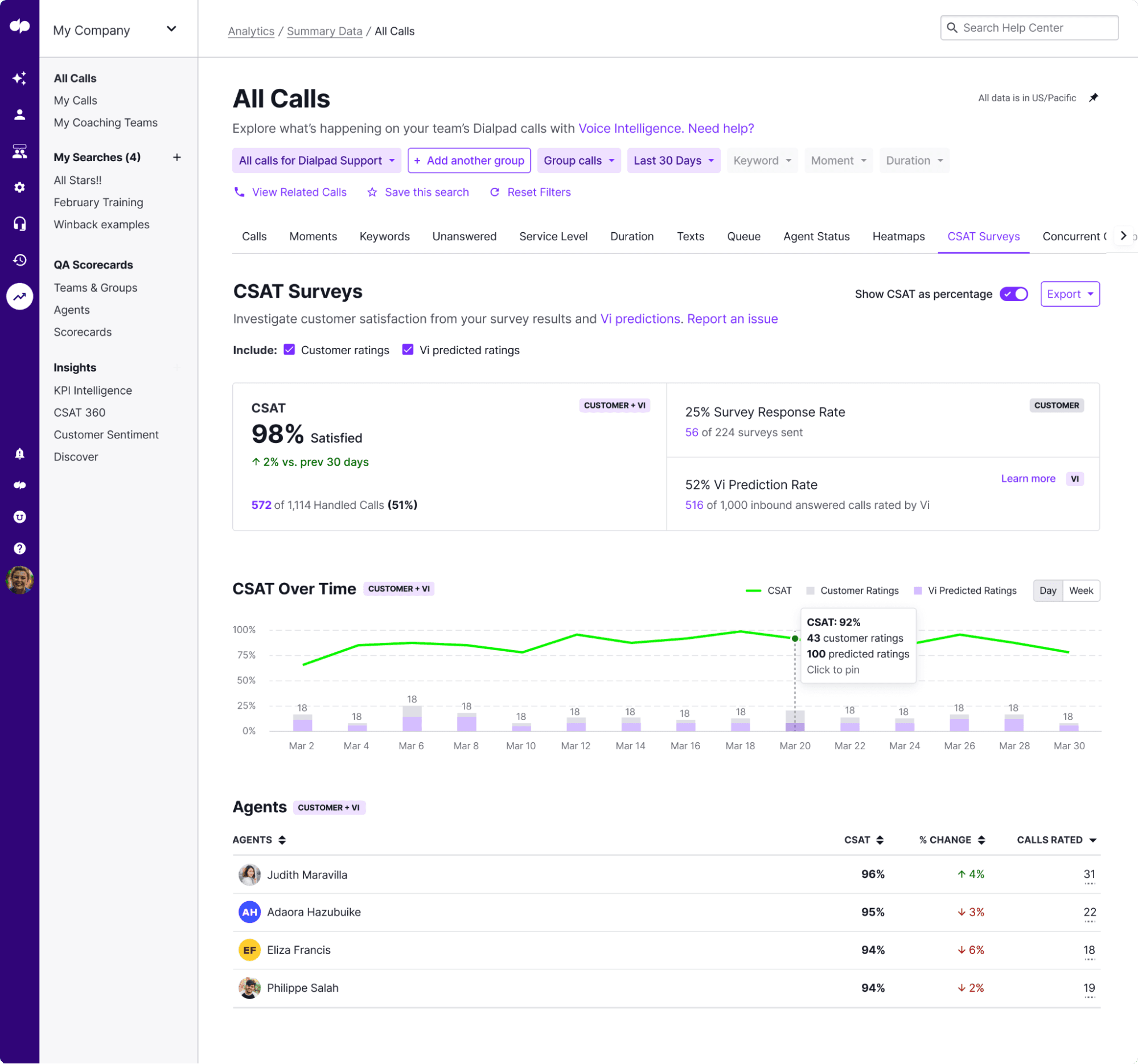
Tags
Share
Customer satisfaction is (or at least should be) the goal of any customer-facing contact center. Customers call in looking for a resolution to their issue or an answer to their question—they should end the call with a satisfactory answer. But how can you accurately track peoples’ feelings about your customer service?
The most common metric for tracking customer satisfaction is CSAT. This gives you a score based on customer surveys—the happier the customer, the better the score.
There’s just one problem: not every customer fills out a survey. In fact, based on our research, only about 3% of customers actually answer CSAT surveys. On top of that, those who do fill them out are typically either the angriest or the happiest, so agents are just getting answers from the most extreme cases. This hardly gives supervisors a good idea of their teams’ overall performance.
So clearly contact centers need more CSAT responses if they’re to get a more representative (and accurate) score. With that in mind, how can contact centers get more CSAT insights—without paying huge incentives for customers to fill out these surveys?
3 ways to get more CSAT insights
Reminders before and after the call
Sometimes, all it takes is a little nudge. The most common method for getting customers to fill out surveys is just to ask them.
A message at the start of the call can let the customer know that there will be a survey afterwards, and they should hang around to answer it. Just a little note saying “after the call, please stay on the line for a satisfaction survey” should do the trick. But while that may put the survey in the caller’s mind, it’s just a recorded message—why should they do what it says?
That’s why agents should also mention the survey at the end of the call. Saying “If you’d like to stay on the line and answer a customer satisfaction survey, I’d really appreciate it” reminds the customer of the survey and (hopefully) gives them an opportunity to pay the agent back for their aid. If the call went well, customers are usually more likely to answer the surveys if they feel it can help the agent.
Although that alone often isn’t enough to get the customers to stay on the line, so you can also incentivize customers to answer CSAT surveys with small rewards or gifts. Things like discounts, gift cards, or even entries into drawings can help motivate customers, since they feel they’ll be getting something back for the extra time it takes to fill out a survey.
And of course, timing is everything. It’s best to send the survey when the call is still on the customer’s mind, so having it right after the call is recommended. If you wait too long, the customer will have already forgotten about it, or feel less incentivized to answer the survey—it’s important to strike while the iron is hot (and hopefully tempers aren’t).
Text them the survey
Most customer satisfaction surveys require the customer to stay on the line while they answer questions. But they already got their resolution, why should they stay on a call?
Well, what if they didn’t have to?
Sending SMS CSAT surveys allows customers to respond on their own time, rather than staying on the line. This helps improve the likelihood of them answering the survey, since they can do it when they’re ready, rather than needing to do it immediately or not at all.
Of course, Dialpad allows contact centers to send CSAT surveys as SMS messages, and customers like Westward360 have found that SMS CSAT has a much higher response rate than any other channels. If a customer hangs up before they get to a phone survey, they’ll still get the text message, and it’ll be there waiting when they’re ready to answer.

Ai CSAT
The above methods are helpful ways for getting customers to answer CSAT surveys, but what if they didn’t need to fill out a survey at all?
Ai CSAT provides insights into customer satisfaction based on the call, not from surveys. To quickly summarize how it works: Ai CSAT uses Dialpad Ai’s natural language processing and speech recognition to identify user sentiment, picks up phrases like “you’ve been a great help, thank you” to rate the customer’s satisfaction, and provides that as a CSAT score.
What this means is that contact centers can get CSAT scores for every call—not just the happiest or angriest 3% of customers that leave responses:

In fact, Ai CSAT has been shown to lead to higher CSAT scores overall—typically around 15% higher in less than three weeks. This is in large part because you’re getting a full look at customer satisfaction, including those who are happy but didn’t fill out a survey. But Ai CSAT also provides real-time customer intelligence and insights that can help agents provide the best service possible.
And those accurate satisfaction scores can really help agents. Looking around on Reddit and Quora, we can also see a common complaint about CSAT surveys: customers leaving low marks for no apparent reason. As one Redditor recounted: “A month-long hot streak of good surveys got broken this week because of two customers who acted nice, told me I helped them, seemed grateful that I stayed on the phone longer than normal to explain things to them, and then left a terrible survey with no comment.”
While Ai CSAT won’t stop the customers from leaving scores like this, it can at least help mitigate their impact. Ai CSAT will collect more scores from customers who don’t fill out surveys, which will provide a better, more holistic and accurate view of the agent’s overall customer satisfaction.
On top of that, Dialpad Support automatically transcribes calls, so contact center supervisors can look at these calls with low marks and see that the agent did do their job and the customer was satisfied. This means the agent is less likely to be penalized for inexplicable negative marks. (Learn more about CSAT best practices.)
Get the insights your contact center needs
Getting accurate and reliable customer satisfaction surveys can seem like an impossible task. As any contact center agent will tell you, customers can be unreliable when reporting their own experiences—and that’s only in the instances where they actually fill out the survey.
Fortunately, there are some great methods for encouraging customers to answer surveys. Even if none of them will give you a 100% response rate on their own, every new survey gives you a better understanding of how your contact centers are performing.
And for the best overview of customer satisfaction, Ai CSAT can give you accurate and impartial satisfaction scores, as well as a holistic look at how agents are performing. This will help ensure customers are happy, and your agents are at their best.
See Dialpad Support in action!
Get a personalized walkthrough of Dialpad Support and see how it can help your CSAT scores. Or, take a self-guided interactive tour of the app!

